Project Charter: Development of Customer Relationship System at TOSIG
VerifiedAdded on 2021/05/31
|14
|2893
|48
Project
AI Summary
This project charter details the development of a cloud computing customer relationship system for Tier One Supplier's Insurance Group (TOSIG) by XYZ Business Consultancy. The project, with a budget of $10,000 and a six-month timeline, aims to improve customer relations and streamline operations. The scope includes developing a mobile work system, providing customers with access to information via cloud computing, and training users. The charter outlines project requirements, deliverables, and in-frame/out-frame items. It includes a business case justifying the project's need, a SWOT analysis, and a milestone schedule. The charter also addresses project risks, assumptions, constraints, and stakeholder management, including a risk register and stakeholder communication plan. The document emphasizes the importance of scope control, risk mitigation, and stakeholder engagement to ensure project success.
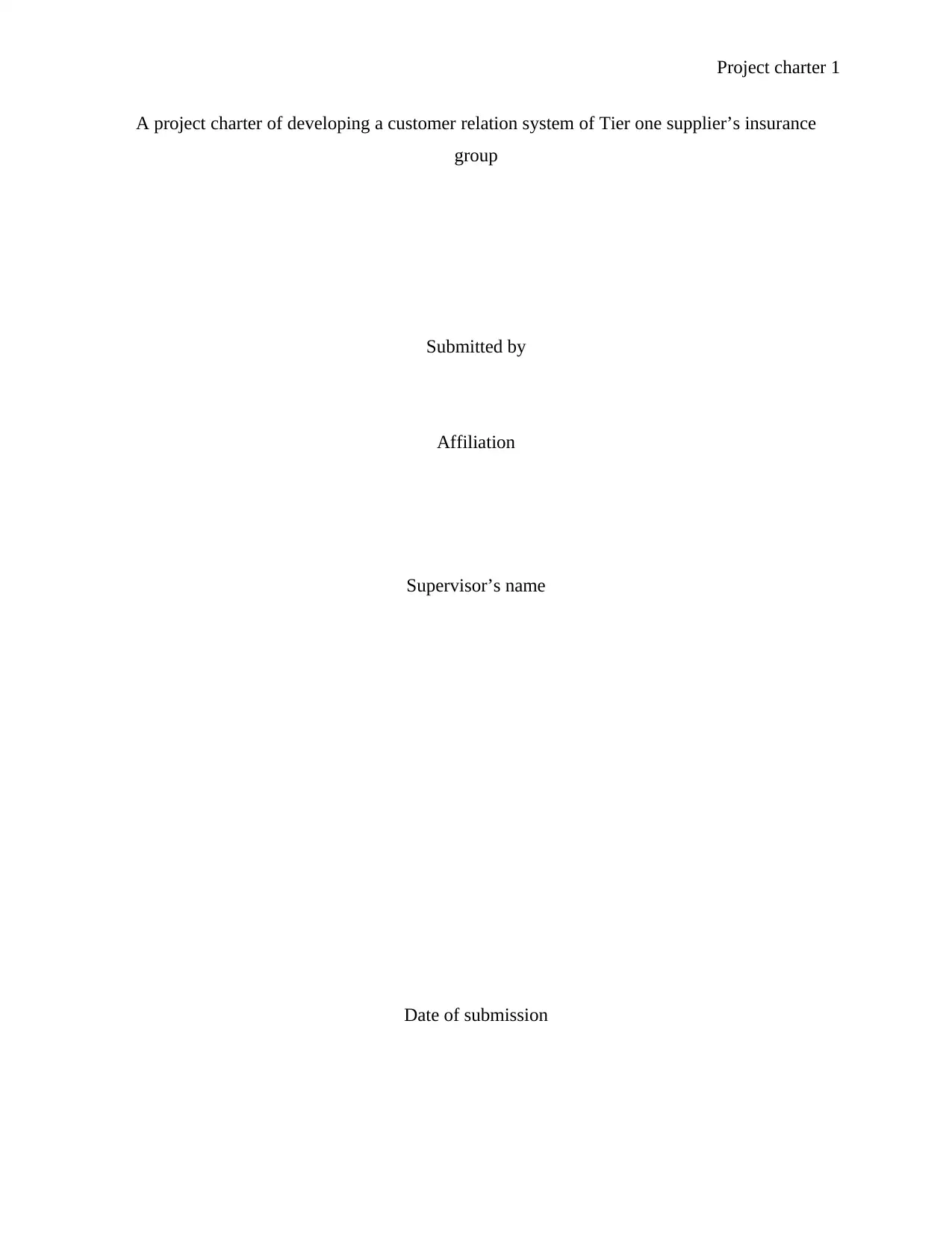
Project charter 1
A project charter of developing a customer relation system of Tier one supplier’s insurance
group
Submitted by
Affiliation
Supervisor’s name
Date of submission
A project charter of developing a customer relation system of Tier one supplier’s insurance
group
Submitted by
Affiliation
Supervisor’s name
Date of submission
Paraphrase This Document
Need a fresh take? Get an instant paraphrase of this document with our AI Paraphraser
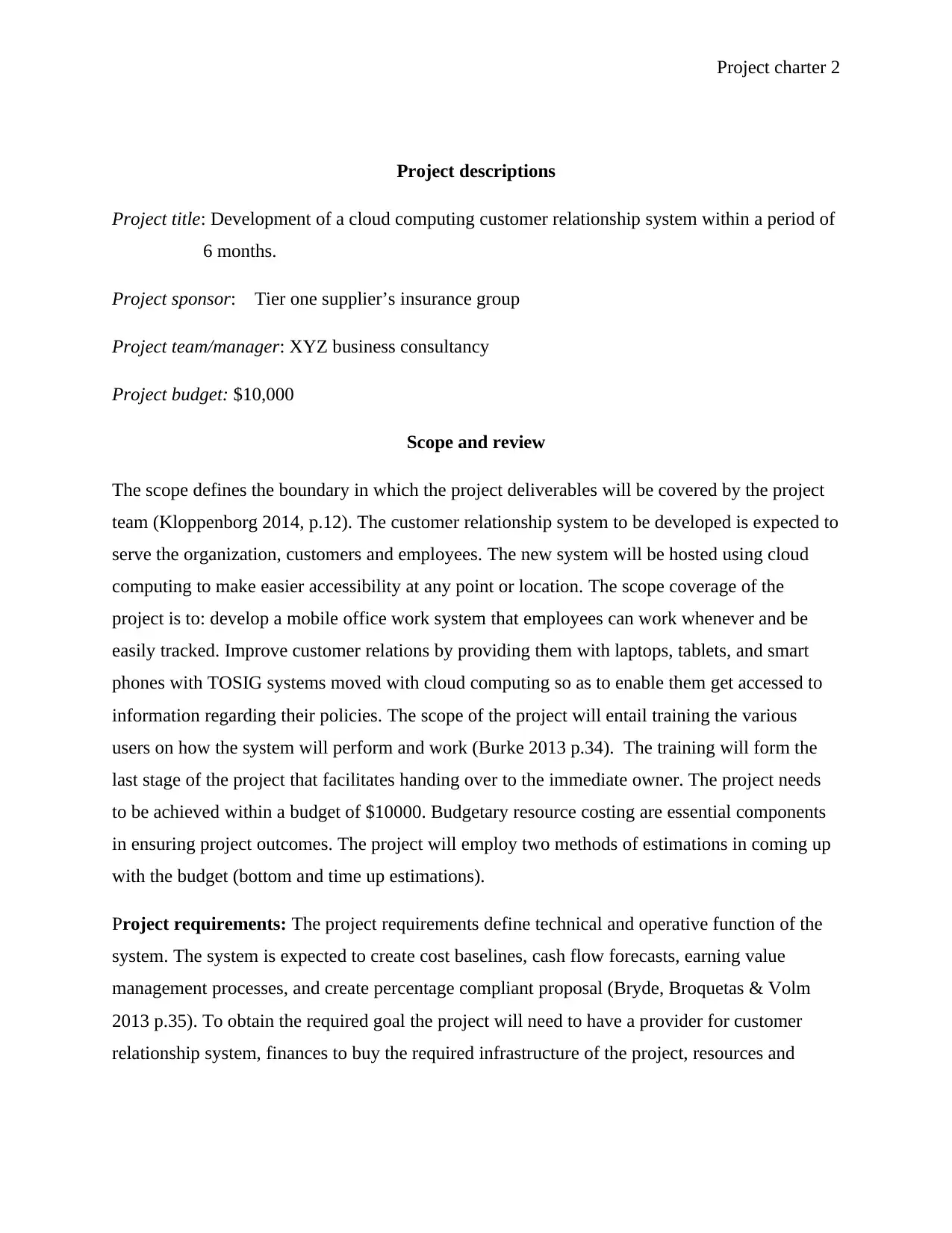
Project charter 2
Project descriptions
Project title: Development of a cloud computing customer relationship system within a period of
6 months.
Project sponsor: Tier one supplier’s insurance group
Project team/manager: XYZ business consultancy
Project budget: $10,000
Scope and review
The scope defines the boundary in which the project deliverables will be covered by the project
team (Kloppenborg 2014, p.12). The customer relationship system to be developed is expected to
serve the organization, customers and employees. The new system will be hosted using cloud
computing to make easier accessibility at any point or location. The scope coverage of the
project is to: develop a mobile office work system that employees can work whenever and be
easily tracked. Improve customer relations by providing them with laptops, tablets, and smart
phones with TOSIG systems moved with cloud computing so as to enable them get accessed to
information regarding their policies. The scope of the project will entail training the various
users on how the system will perform and work (Burke 2013 p.34). The training will form the
last stage of the project that facilitates handing over to the immediate owner. The project needs
to be achieved within a budget of $10000. Budgetary resource costing are essential components
in ensuring project outcomes. The project will employ two methods of estimations in coming up
with the budget (bottom and time up estimations).
Project requirements: The project requirements define technical and operative function of the
system. The system is expected to create cost baselines, cash flow forecasts, earning value
management processes, and create percentage compliant proposal (Bryde, Broquetas & Volm
2013 p.35). To obtain the required goal the project will need to have a provider for customer
relationship system, finances to buy the required infrastructure of the project, resources and
Project descriptions
Project title: Development of a cloud computing customer relationship system within a period of
6 months.
Project sponsor: Tier one supplier’s insurance group
Project team/manager: XYZ business consultancy
Project budget: $10,000
Scope and review
The scope defines the boundary in which the project deliverables will be covered by the project
team (Kloppenborg 2014, p.12). The customer relationship system to be developed is expected to
serve the organization, customers and employees. The new system will be hosted using cloud
computing to make easier accessibility at any point or location. The scope coverage of the
project is to: develop a mobile office work system that employees can work whenever and be
easily tracked. Improve customer relations by providing them with laptops, tablets, and smart
phones with TOSIG systems moved with cloud computing so as to enable them get accessed to
information regarding their policies. The scope of the project will entail training the various
users on how the system will perform and work (Burke 2013 p.34). The training will form the
last stage of the project that facilitates handing over to the immediate owner. The project needs
to be achieved within a budget of $10000. Budgetary resource costing are essential components
in ensuring project outcomes. The project will employ two methods of estimations in coming up
with the budget (bottom and time up estimations).
Project requirements: The project requirements define technical and operative function of the
system. The system is expected to create cost baselines, cash flow forecasts, earning value
management processes, and create percentage compliant proposal (Bryde, Broquetas & Volm
2013 p.35). To obtain the required goal the project will need to have a provider for customer
relationship system, finances to buy the required infrastructure of the project, resources and
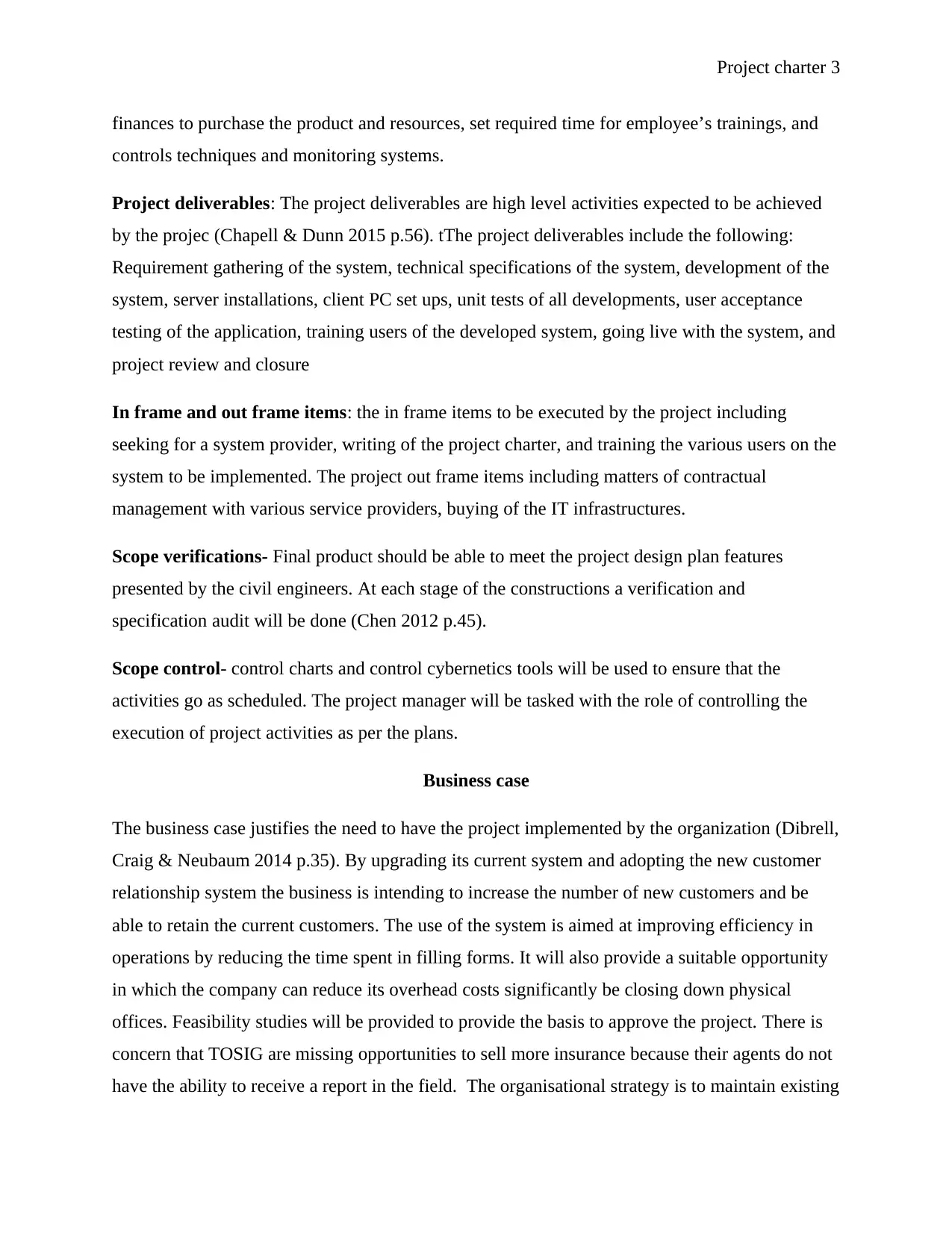
Project charter 3
finances to purchase the product and resources, set required time for employee’s trainings, and
controls techniques and monitoring systems.
Project deliverables: The project deliverables are high level activities expected to be achieved
by the projec (Chapell & Dunn 2015 p.56). tThe project deliverables include the following:
Requirement gathering of the system, technical specifications of the system, development of the
system, server installations, client PC set ups, unit tests of all developments, user acceptance
testing of the application, training users of the developed system, going live with the system, and
project review and closure
In frame and out frame items: the in frame items to be executed by the project including
seeking for a system provider, writing of the project charter, and training the various users on the
system to be implemented. The project out frame items including matters of contractual
management with various service providers, buying of the IT infrastructures.
Scope verifications- Final product should be able to meet the project design plan features
presented by the civil engineers. At each stage of the constructions a verification and
specification audit will be done (Chen 2012 p.45).
Scope control- control charts and control cybernetics tools will be used to ensure that the
activities go as scheduled. The project manager will be tasked with the role of controlling the
execution of project activities as per the plans.
Business case
The business case justifies the need to have the project implemented by the organization (Dibrell,
Craig & Neubaum 2014 p.35). By upgrading its current system and adopting the new customer
relationship system the business is intending to increase the number of new customers and be
able to retain the current customers. The use of the system is aimed at improving efficiency in
operations by reducing the time spent in filling forms. It will also provide a suitable opportunity
in which the company can reduce its overhead costs significantly be closing down physical
offices. Feasibility studies will be provided to provide the basis to approve the project. There is
concern that TOSIG are missing opportunities to sell more insurance because their agents do not
have the ability to receive a report in the field. The organisational strategy is to maintain existing
finances to purchase the product and resources, set required time for employee’s trainings, and
controls techniques and monitoring systems.
Project deliverables: The project deliverables are high level activities expected to be achieved
by the projec (Chapell & Dunn 2015 p.56). tThe project deliverables include the following:
Requirement gathering of the system, technical specifications of the system, development of the
system, server installations, client PC set ups, unit tests of all developments, user acceptance
testing of the application, training users of the developed system, going live with the system, and
project review and closure
In frame and out frame items: the in frame items to be executed by the project including
seeking for a system provider, writing of the project charter, and training the various users on the
system to be implemented. The project out frame items including matters of contractual
management with various service providers, buying of the IT infrastructures.
Scope verifications- Final product should be able to meet the project design plan features
presented by the civil engineers. At each stage of the constructions a verification and
specification audit will be done (Chen 2012 p.45).
Scope control- control charts and control cybernetics tools will be used to ensure that the
activities go as scheduled. The project manager will be tasked with the role of controlling the
execution of project activities as per the plans.
Business case
The business case justifies the need to have the project implemented by the organization (Dibrell,
Craig & Neubaum 2014 p.35). By upgrading its current system and adopting the new customer
relationship system the business is intending to increase the number of new customers and be
able to retain the current customers. The use of the system is aimed at improving efficiency in
operations by reducing the time spent in filling forms. It will also provide a suitable opportunity
in which the company can reduce its overhead costs significantly be closing down physical
offices. Feasibility studies will be provided to provide the basis to approve the project. There is
concern that TOSIG are missing opportunities to sell more insurance because their agents do not
have the ability to receive a report in the field. The organisational strategy is to maintain existing
⊘ This is a preview!⊘
Do you want full access?
Subscribe today to unlock all pages.

Trusted by 1+ million students worldwide
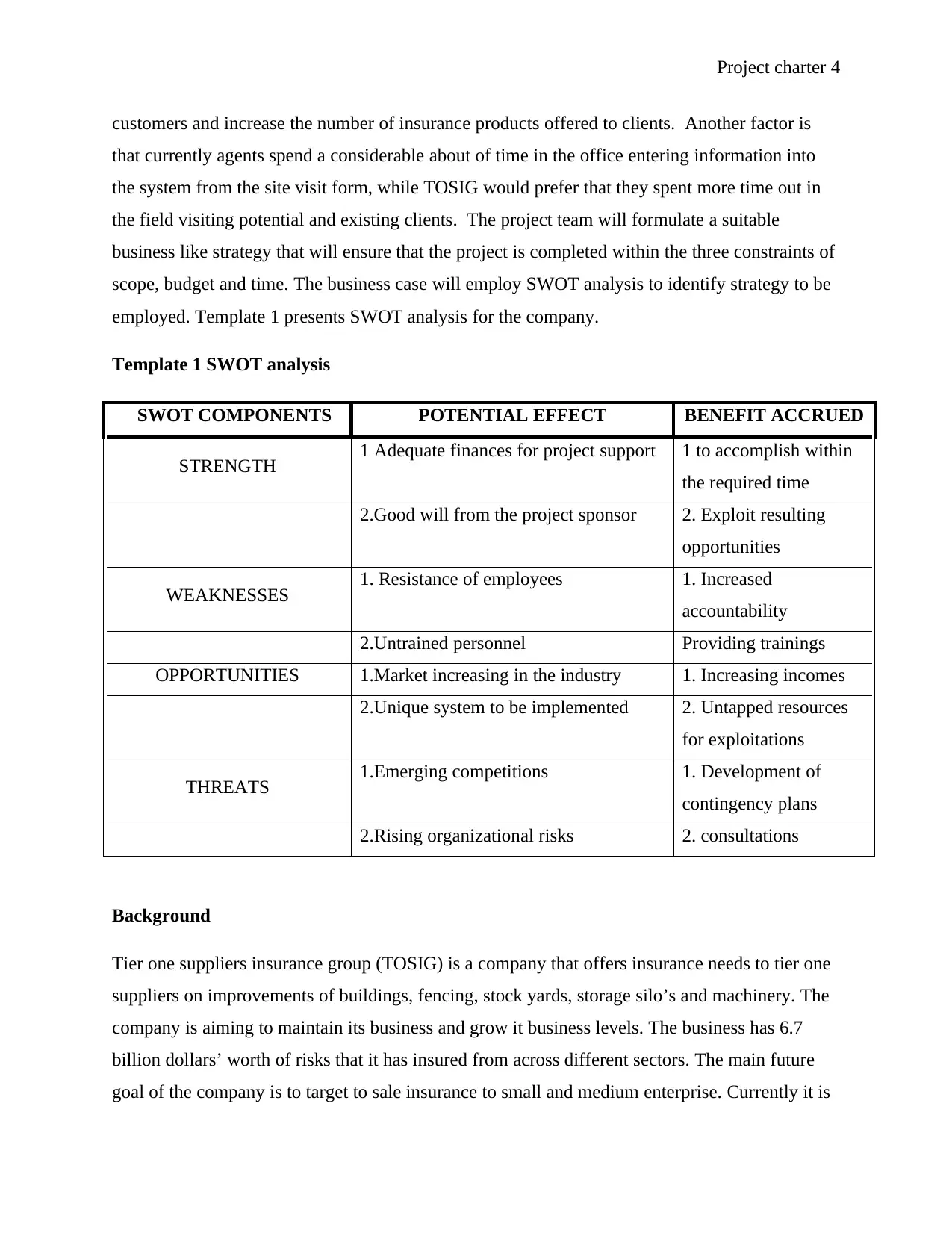
Project charter 4
customers and increase the number of insurance products offered to clients. Another factor is
that currently agents spend a considerable about of time in the office entering information into
the system from the site visit form, while TOSIG would prefer that they spent more time out in
the field visiting potential and existing clients. The project team will formulate a suitable
business like strategy that will ensure that the project is completed within the three constraints of
scope, budget and time. The business case will employ SWOT analysis to identify strategy to be
employed. Template 1 presents SWOT analysis for the company.
Template 1 SWOT analysis
SWOT COMPONENTS POTENTIAL EFFECT BENEFIT ACCRUED
STRENGTH 1 Adequate finances for project support 1 to accomplish within
the required time
2.Good will from the project sponsor 2. Exploit resulting
opportunities
WEAKNESSES 1. Resistance of employees 1. Increased
accountability
2.Untrained personnel Providing trainings
OPPORTUNITIES 1.Market increasing in the industry 1. Increasing incomes
2.Unique system to be implemented 2. Untapped resources
for exploitations
THREATS 1.Emerging competitions 1. Development of
contingency plans
2.Rising organizational risks 2. consultations
Background
Tier one suppliers insurance group (TOSIG) is a company that offers insurance needs to tier one
suppliers on improvements of buildings, fencing, stock yards, storage silo’s and machinery. The
company is aiming to maintain its business and grow it business levels. The business has 6.7
billion dollars’ worth of risks that it has insured from across different sectors. The main future
goal of the company is to target to sale insurance to small and medium enterprise. Currently it is
customers and increase the number of insurance products offered to clients. Another factor is
that currently agents spend a considerable about of time in the office entering information into
the system from the site visit form, while TOSIG would prefer that they spent more time out in
the field visiting potential and existing clients. The project team will formulate a suitable
business like strategy that will ensure that the project is completed within the three constraints of
scope, budget and time. The business case will employ SWOT analysis to identify strategy to be
employed. Template 1 presents SWOT analysis for the company.
Template 1 SWOT analysis
SWOT COMPONENTS POTENTIAL EFFECT BENEFIT ACCRUED
STRENGTH 1 Adequate finances for project support 1 to accomplish within
the required time
2.Good will from the project sponsor 2. Exploit resulting
opportunities
WEAKNESSES 1. Resistance of employees 1. Increased
accountability
2.Untrained personnel Providing trainings
OPPORTUNITIES 1.Market increasing in the industry 1. Increasing incomes
2.Unique system to be implemented 2. Untapped resources
for exploitations
THREATS 1.Emerging competitions 1. Development of
contingency plans
2.Rising organizational risks 2. consultations
Background
Tier one suppliers insurance group (TOSIG) is a company that offers insurance needs to tier one
suppliers on improvements of buildings, fencing, stock yards, storage silo’s and machinery. The
company is aiming to maintain its business and grow it business levels. The business has 6.7
billion dollars’ worth of risks that it has insured from across different sectors. The main future
goal of the company is to target to sale insurance to small and medium enterprise. Currently it is
Paraphrase This Document
Need a fresh take? Get an instant paraphrase of this document with our AI Paraphraser
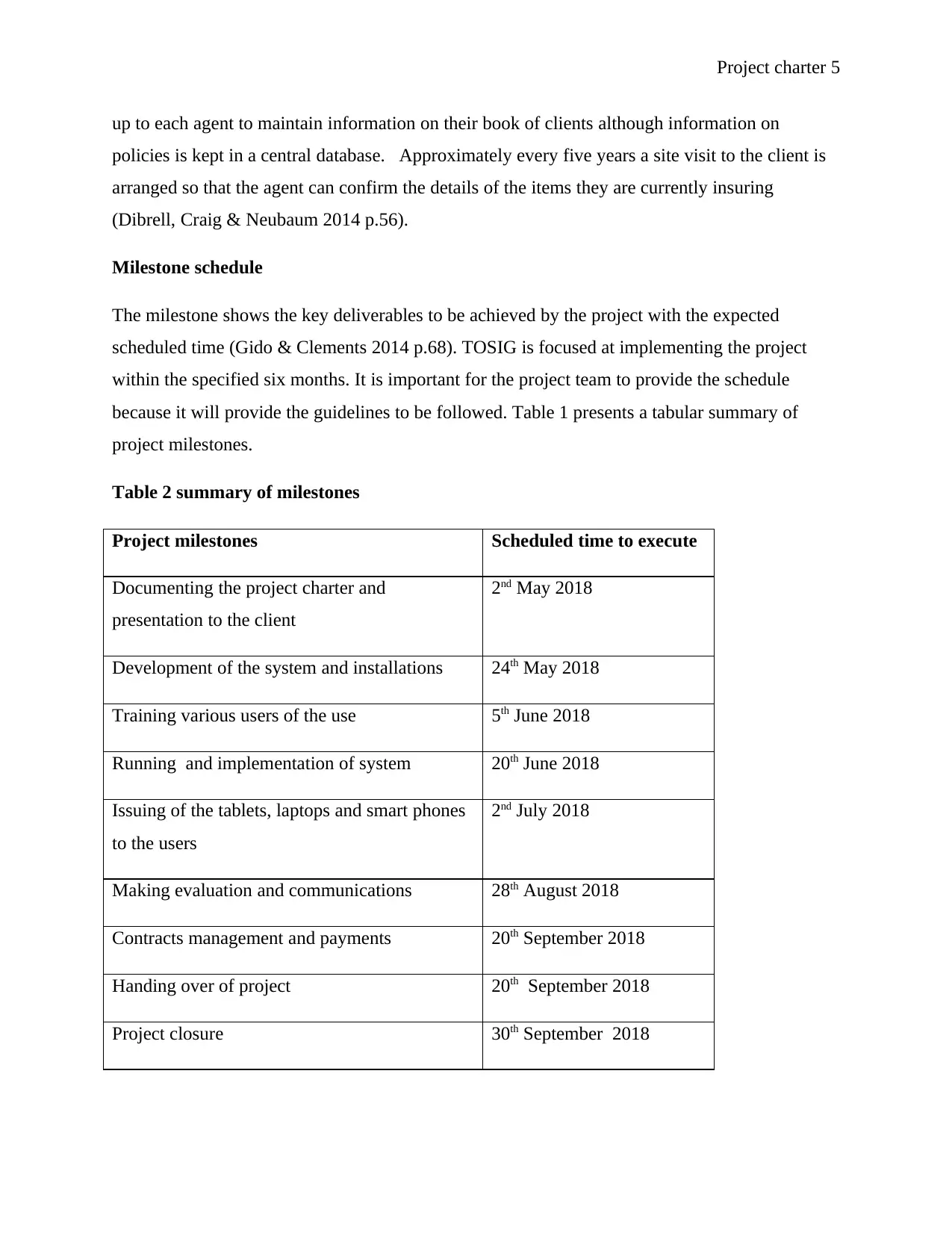
Project charter 5
up to each agent to maintain information on their book of clients although information on
policies is kept in a central database. Approximately every five years a site visit to the client is
arranged so that the agent can confirm the details of the items they are currently insuring
(Dibrell, Craig & Neubaum 2014 p.56).
Milestone schedule
The milestone shows the key deliverables to be achieved by the project with the expected
scheduled time (Gido & Clements 2014 p.68). TOSIG is focused at implementing the project
within the specified six months. It is important for the project team to provide the schedule
because it will provide the guidelines to be followed. Table 1 presents a tabular summary of
project milestones.
Table 2 summary of milestones
Project milestones Scheduled time to execute
Documenting the project charter and
presentation to the client
2nd May 2018
Development of the system and installations 24th May 2018
Training various users of the use 5th June 2018
Running and implementation of system 20th June 2018
Issuing of the tablets, laptops and smart phones
to the users
2nd July 2018
Making evaluation and communications 28th August 2018
Contracts management and payments 20th September 2018
Handing over of project 20th September 2018
Project closure 30th September 2018
up to each agent to maintain information on their book of clients although information on
policies is kept in a central database. Approximately every five years a site visit to the client is
arranged so that the agent can confirm the details of the items they are currently insuring
(Dibrell, Craig & Neubaum 2014 p.56).
Milestone schedule
The milestone shows the key deliverables to be achieved by the project with the expected
scheduled time (Gido & Clements 2014 p.68). TOSIG is focused at implementing the project
within the specified six months. It is important for the project team to provide the schedule
because it will provide the guidelines to be followed. Table 1 presents a tabular summary of
project milestones.
Table 2 summary of milestones
Project milestones Scheduled time to execute
Documenting the project charter and
presentation to the client
2nd May 2018
Development of the system and installations 24th May 2018
Training various users of the use 5th June 2018
Running and implementation of system 20th June 2018
Issuing of the tablets, laptops and smart phones
to the users
2nd July 2018
Making evaluation and communications 28th August 2018
Contracts management and payments 20th September 2018
Handing over of project 20th September 2018
Project closure 30th September 2018
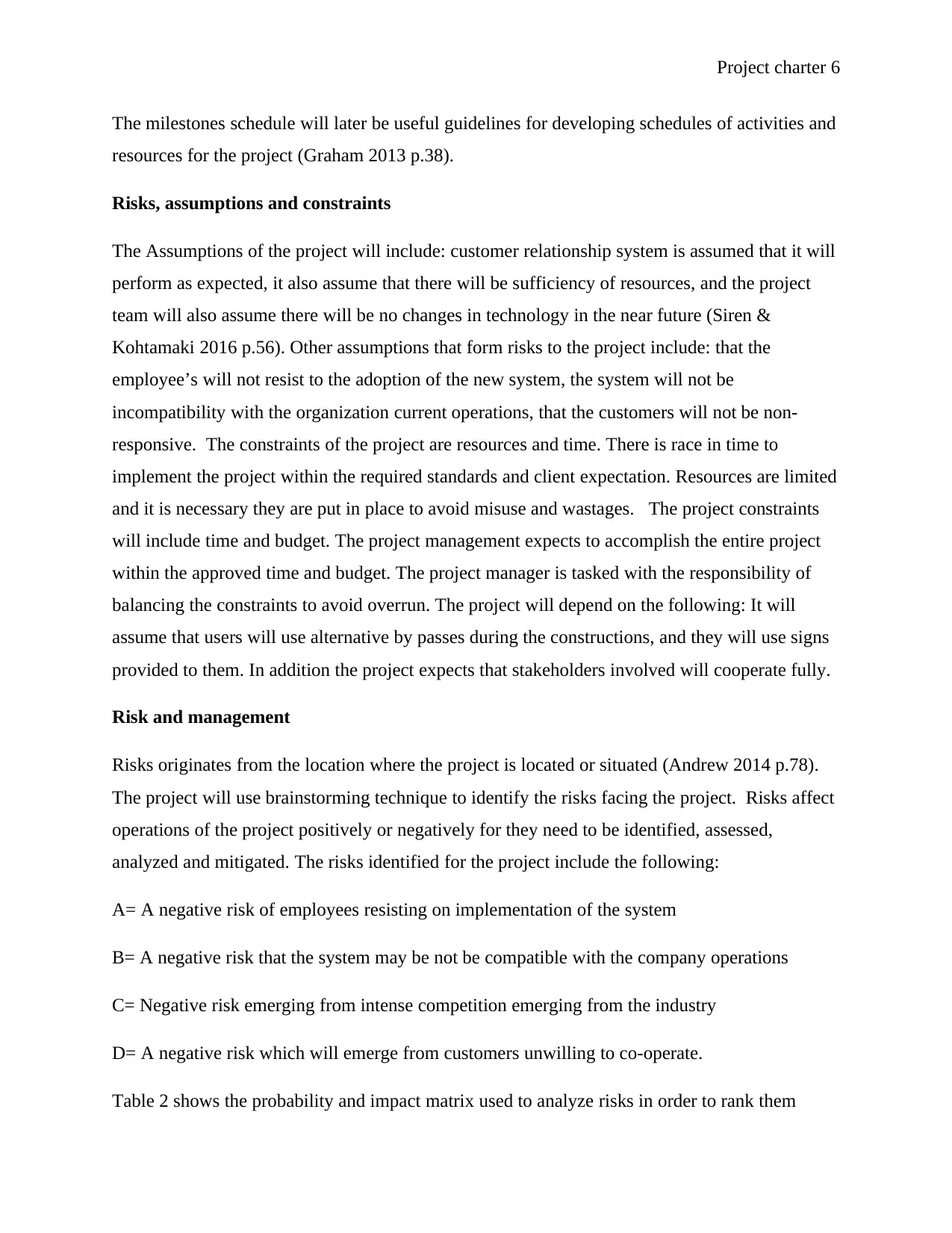
Project charter 6
The milestones schedule will later be useful guidelines for developing schedules of activities and
resources for the project (Graham 2013 p.38).
Risks, assumptions and constraints
The Assumptions of the project will include: customer relationship system is assumed that it will
perform as expected, it also assume that there will be sufficiency of resources, and the project
team will also assume there will be no changes in technology in the near future (Siren &
Kohtamaki 2016 p.56). Other assumptions that form risks to the project include: that the
employee’s will not resist to the adoption of the new system, the system will not be
incompatibility with the organization current operations, that the customers will not be non-
responsive. The constraints of the project are resources and time. There is race in time to
implement the project within the required standards and client expectation. Resources are limited
and it is necessary they are put in place to avoid misuse and wastages. The project constraints
will include time and budget. The project management expects to accomplish the entire project
within the approved time and budget. The project manager is tasked with the responsibility of
balancing the constraints to avoid overrun. The project will depend on the following: It will
assume that users will use alternative by passes during the constructions, and they will use signs
provided to them. In addition the project expects that stakeholders involved will cooperate fully.
Risk and management
Risks originates from the location where the project is located or situated (Andrew 2014 p.78).
The project will use brainstorming technique to identify the risks facing the project. Risks affect
operations of the project positively or negatively for they need to be identified, assessed,
analyzed and mitigated. The risks identified for the project include the following:
A= A negative risk of employees resisting on implementation of the system
B= A negative risk that the system may be not be compatible with the company operations
C= Negative risk emerging from intense competition emerging from the industry
D= A negative risk which will emerge from customers unwilling to co-operate.
Table 2 shows the probability and impact matrix used to analyze risks in order to rank them
The milestones schedule will later be useful guidelines for developing schedules of activities and
resources for the project (Graham 2013 p.38).
Risks, assumptions and constraints
The Assumptions of the project will include: customer relationship system is assumed that it will
perform as expected, it also assume that there will be sufficiency of resources, and the project
team will also assume there will be no changes in technology in the near future (Siren &
Kohtamaki 2016 p.56). Other assumptions that form risks to the project include: that the
employee’s will not resist to the adoption of the new system, the system will not be
incompatibility with the organization current operations, that the customers will not be non-
responsive. The constraints of the project are resources and time. There is race in time to
implement the project within the required standards and client expectation. Resources are limited
and it is necessary they are put in place to avoid misuse and wastages. The project constraints
will include time and budget. The project management expects to accomplish the entire project
within the approved time and budget. The project manager is tasked with the responsibility of
balancing the constraints to avoid overrun. The project will depend on the following: It will
assume that users will use alternative by passes during the constructions, and they will use signs
provided to them. In addition the project expects that stakeholders involved will cooperate fully.
Risk and management
Risks originates from the location where the project is located or situated (Andrew 2014 p.78).
The project will use brainstorming technique to identify the risks facing the project. Risks affect
operations of the project positively or negatively for they need to be identified, assessed,
analyzed and mitigated. The risks identified for the project include the following:
A= A negative risk of employees resisting on implementation of the system
B= A negative risk that the system may be not be compatible with the company operations
C= Negative risk emerging from intense competition emerging from the industry
D= A negative risk which will emerge from customers unwilling to co-operate.
Table 2 shows the probability and impact matrix used to analyze risks in order to rank them
⊘ This is a preview!⊘
Do you want full access?
Subscribe today to unlock all pages.

Trusted by 1+ million students worldwide
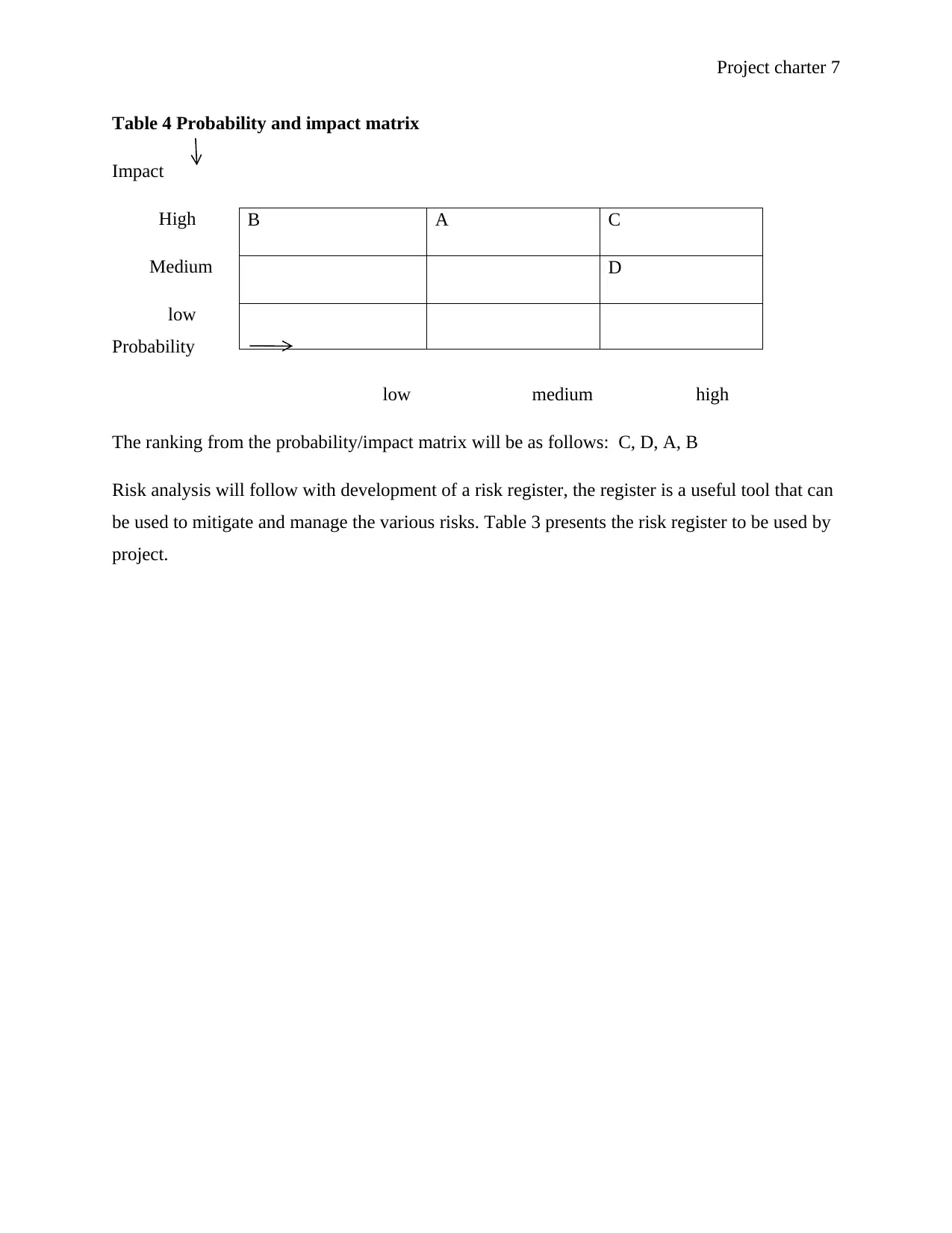
Project charter 7
Table 4 Probability and impact matrix
Impact
High
Medium
low
Probability
low medium high
The ranking from the probability/impact matrix will be as follows: C, D, A, B
Risk analysis will follow with development of a risk register, the register is a useful tool that can
be used to mitigate and manage the various risks. Table 3 presents the risk register to be used by
project.
B A C
D
Table 4 Probability and impact matrix
Impact
High
Medium
low
Probability
low medium high
The ranking from the probability/impact matrix will be as follows: C, D, A, B
Risk analysis will follow with development of a risk register, the register is a useful tool that can
be used to mitigate and manage the various risks. Table 3 presents the risk register to be used by
project.
B A C
D
Paraphrase This Document
Need a fresh take? Get an instant paraphrase of this document with our AI Paraphraser
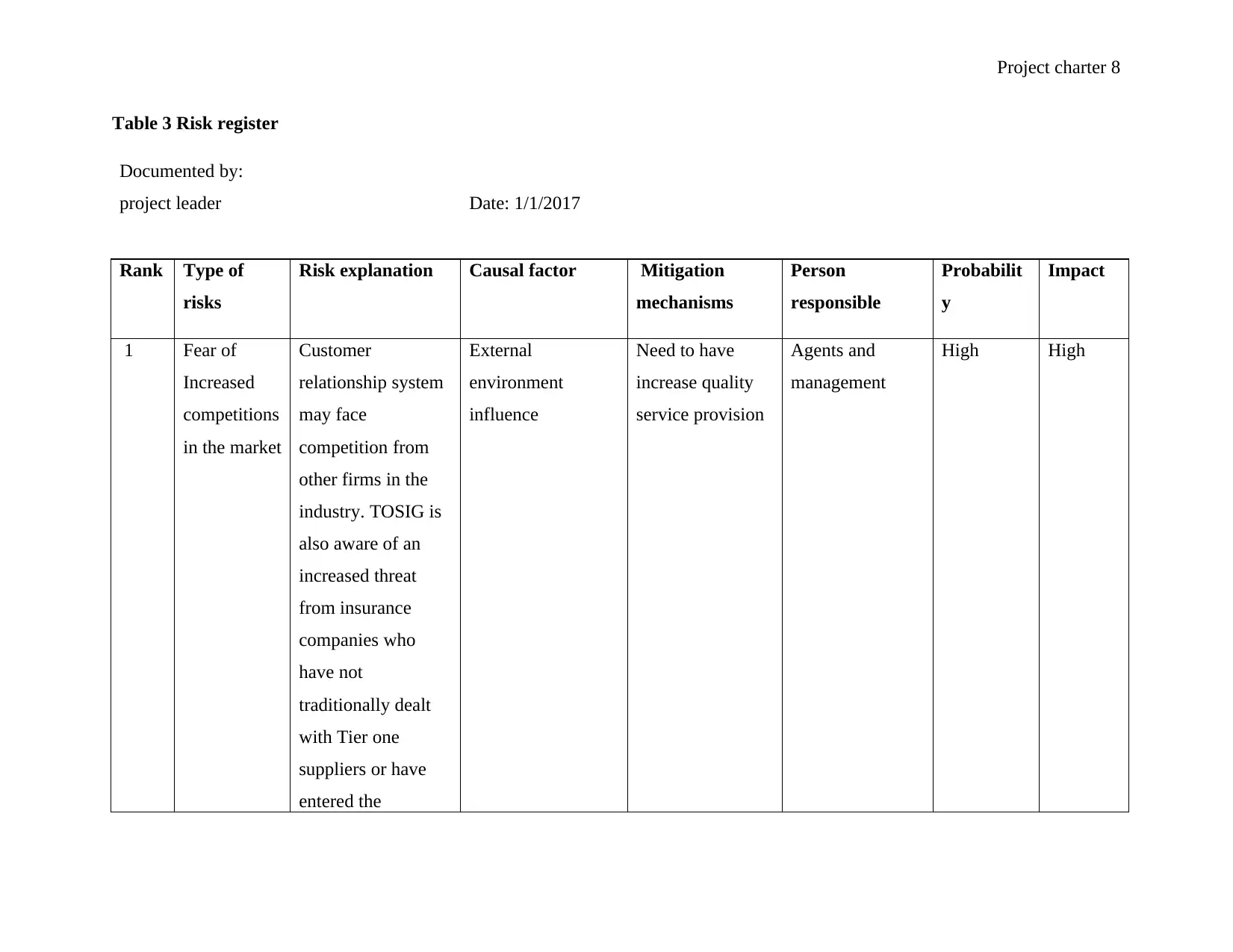
Project charter 8
Table 3 Risk register
Documented by:
project leader Date: 1/1/2017
Rank Type of
risks
Risk explanation Causal factor Mitigation
mechanisms
Person
responsible
Probabilit
y
Impact
1 Fear of
Increased
competitions
in the market
Customer
relationship system
may face
competition from
other firms in the
industry. TOSIG is
also aware of an
increased threat
from insurance
companies who
have not
traditionally dealt
with Tier one
suppliers or have
entered the
External
environment
influence
Need to have
increase quality
service provision
Agents and
management
High High
Table 3 Risk register
Documented by:
project leader Date: 1/1/2017
Rank Type of
risks
Risk explanation Causal factor Mitigation
mechanisms
Person
responsible
Probabilit
y
Impact
1 Fear of
Increased
competitions
in the market
Customer
relationship system
may face
competition from
other firms in the
industry. TOSIG is
also aware of an
increased threat
from insurance
companies who
have not
traditionally dealt
with Tier one
suppliers or have
entered the
External
environment
influence
Need to have
increase quality
service provision
Agents and
management
High High
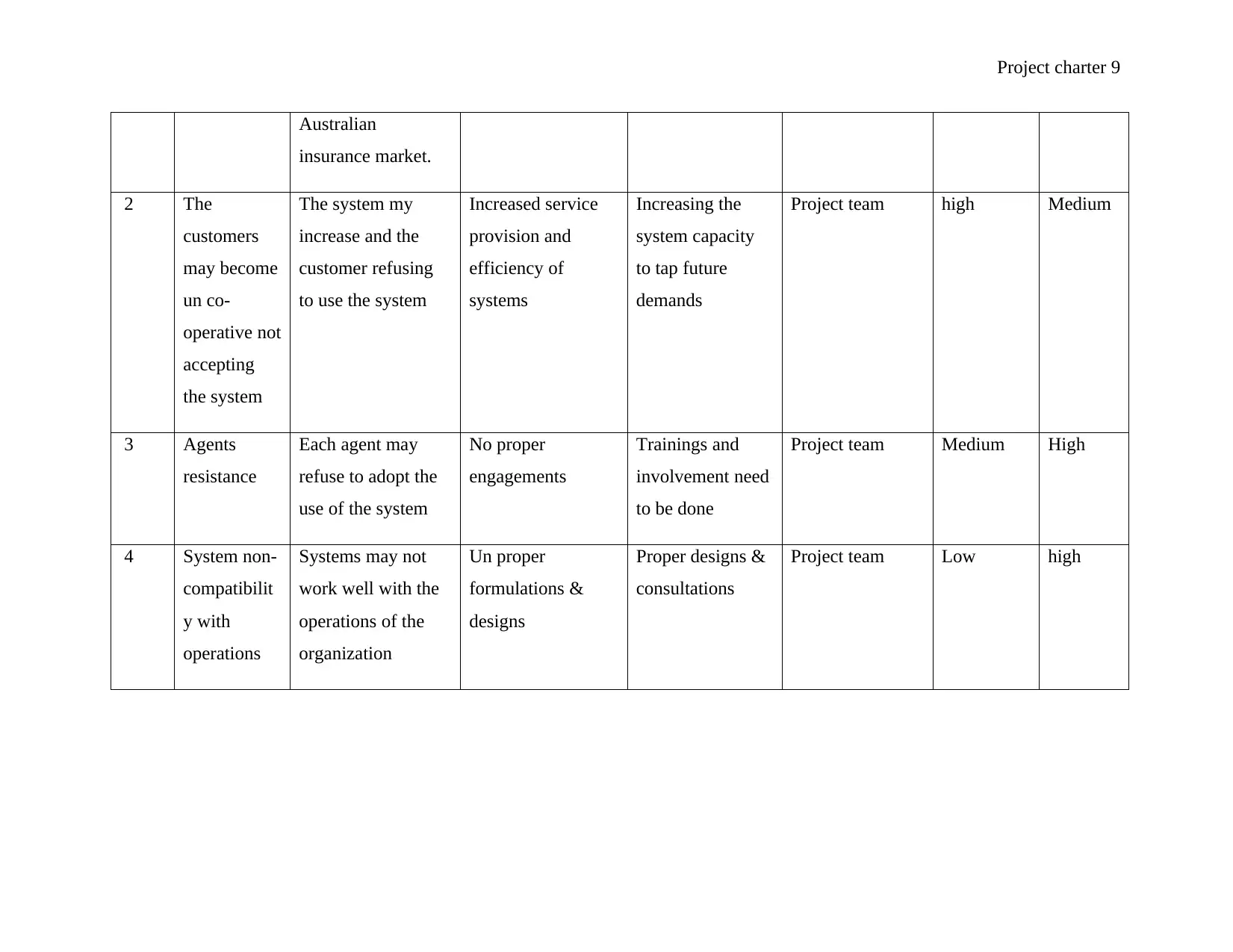
Project charter 9
Australian
insurance market.
2 The
customers
may become
un co-
operative not
accepting
the system
The system my
increase and the
customer refusing
to use the system
Increased service
provision and
efficiency of
systems
Increasing the
system capacity
to tap future
demands
Project team high Medium
3 Agents
resistance
Each agent may
refuse to adopt the
use of the system
No proper
engagements
Trainings and
involvement need
to be done
Project team Medium High
4 System non-
compatibilit
y with
operations
Systems may not
work well with the
operations of the
organization
Un proper
formulations &
designs
Proper designs &
consultations
Project team Low high
Australian
insurance market.
2 The
customers
may become
un co-
operative not
accepting
the system
The system my
increase and the
customer refusing
to use the system
Increased service
provision and
efficiency of
systems
Increasing the
system capacity
to tap future
demands
Project team high Medium
3 Agents
resistance
Each agent may
refuse to adopt the
use of the system
No proper
engagements
Trainings and
involvement need
to be done
Project team Medium High
4 System non-
compatibilit
y with
operations
Systems may not
work well with the
operations of the
organization
Un proper
formulations &
designs
Proper designs &
consultations
Project team Low high
⊘ This is a preview!⊘
Do you want full access?
Subscribe today to unlock all pages.

Trusted by 1+ million students worldwide
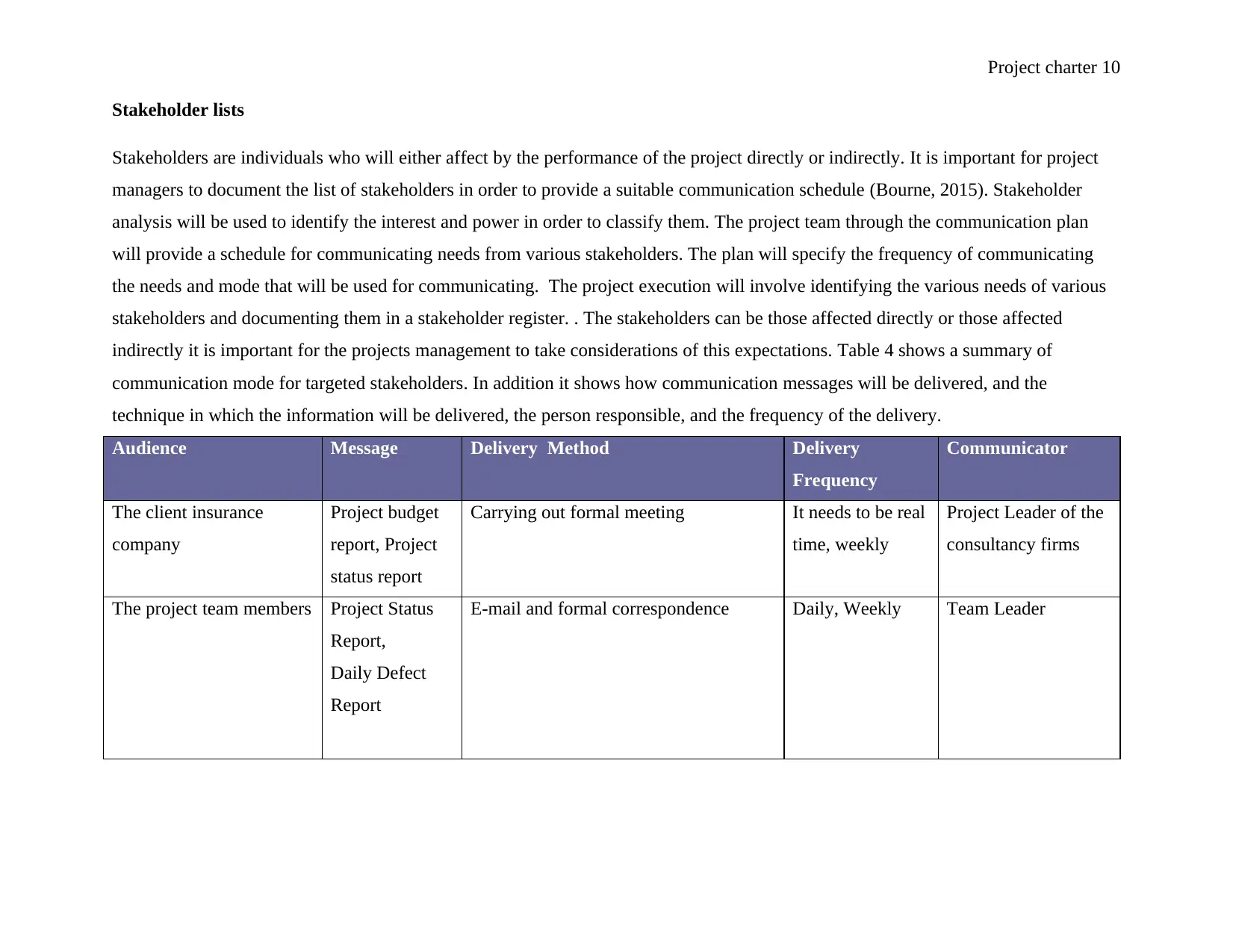
Project charter 10
Stakeholder lists
Stakeholders are individuals who will either affect by the performance of the project directly or indirectly. It is important for project
managers to document the list of stakeholders in order to provide a suitable communication schedule (Bourne, 2015). Stakeholder
analysis will be used to identify the interest and power in order to classify them. The project team through the communication plan
will provide a schedule for communicating needs from various stakeholders. The plan will specify the frequency of communicating
the needs and mode that will be used for communicating. The project execution will involve identifying the various needs of various
stakeholders and documenting them in a stakeholder register. . The stakeholders can be those affected directly or those affected
indirectly it is important for the projects management to take considerations of this expectations. Table 4 shows a summary of
communication mode for targeted stakeholders. In addition it shows how communication messages will be delivered, and the
technique in which the information will be delivered, the person responsible, and the frequency of the delivery.
Audience Message Delivery Method Delivery
Frequency
Communicator
The client insurance
company
Project budget
report, Project
status report
Carrying out formal meeting It needs to be real
time, weekly
Project Leader of the
consultancy firms
The project team members Project Status
Report,
Daily Defect
Report
E-mail and formal correspondence Daily, Weekly Team Leader
Stakeholder lists
Stakeholders are individuals who will either affect by the performance of the project directly or indirectly. It is important for project
managers to document the list of stakeholders in order to provide a suitable communication schedule (Bourne, 2015). Stakeholder
analysis will be used to identify the interest and power in order to classify them. The project team through the communication plan
will provide a schedule for communicating needs from various stakeholders. The plan will specify the frequency of communicating
the needs and mode that will be used for communicating. The project execution will involve identifying the various needs of various
stakeholders and documenting them in a stakeholder register. . The stakeholders can be those affected directly or those affected
indirectly it is important for the projects management to take considerations of this expectations. Table 4 shows a summary of
communication mode for targeted stakeholders. In addition it shows how communication messages will be delivered, and the
technique in which the information will be delivered, the person responsible, and the frequency of the delivery.
Audience Message Delivery Method Delivery
Frequency
Communicator
The client insurance
company
Project budget
report, Project
status report
Carrying out formal meeting It needs to be real
time, weekly
Project Leader of the
consultancy firms
The project team members Project Status
Report,
Daily Defect
Report
E-mail and formal correspondence Daily, Weekly Team Leader
Paraphrase This Document
Need a fresh take? Get an instant paraphrase of this document with our AI Paraphraser
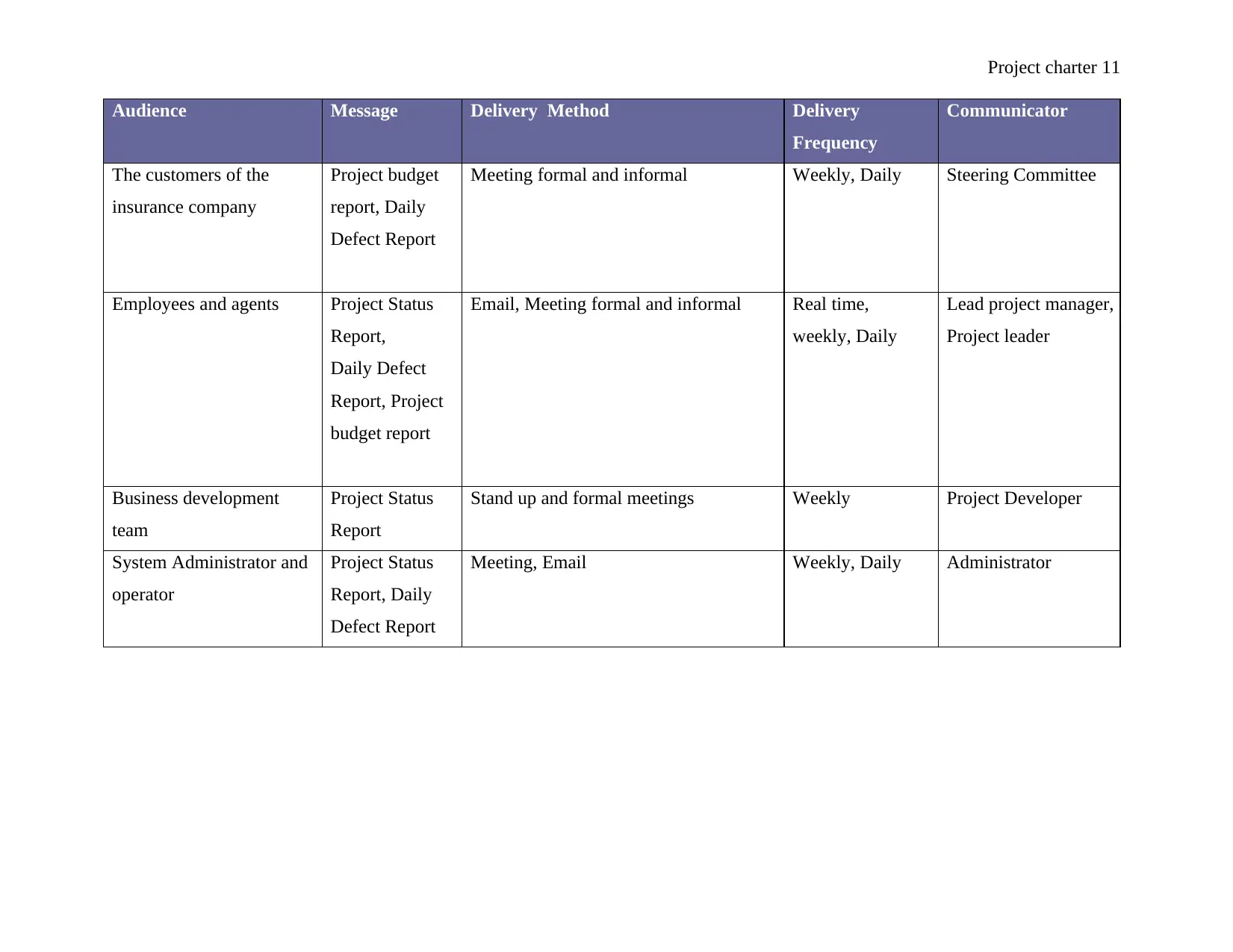
Project charter 11
Audience Message Delivery Method Delivery
Frequency
Communicator
The customers of the
insurance company
Project budget
report, Daily
Defect Report
Meeting formal and informal Weekly, Daily Steering Committee
Employees and agents Project Status
Report,
Daily Defect
Report, Project
budget report
Email, Meeting formal and informal Real time,
weekly, Daily
Lead project manager,
Project leader
Business development
team
Project Status
Report
Stand up and formal meetings Weekly Project Developer
System Administrator and
operator
Project Status
Report, Daily
Defect Report
Meeting, Email Weekly, Daily Administrator
Audience Message Delivery Method Delivery
Frequency
Communicator
The customers of the
insurance company
Project budget
report, Daily
Defect Report
Meeting formal and informal Weekly, Daily Steering Committee
Employees and agents Project Status
Report,
Daily Defect
Report, Project
budget report
Email, Meeting formal and informal Real time,
weekly, Daily
Lead project manager,
Project leader
Business development
team
Project Status
Report
Stand up and formal meetings Weekly Project Developer
System Administrator and
operator
Project Status
Report, Daily
Defect Report
Meeting, Email Weekly, Daily Administrator
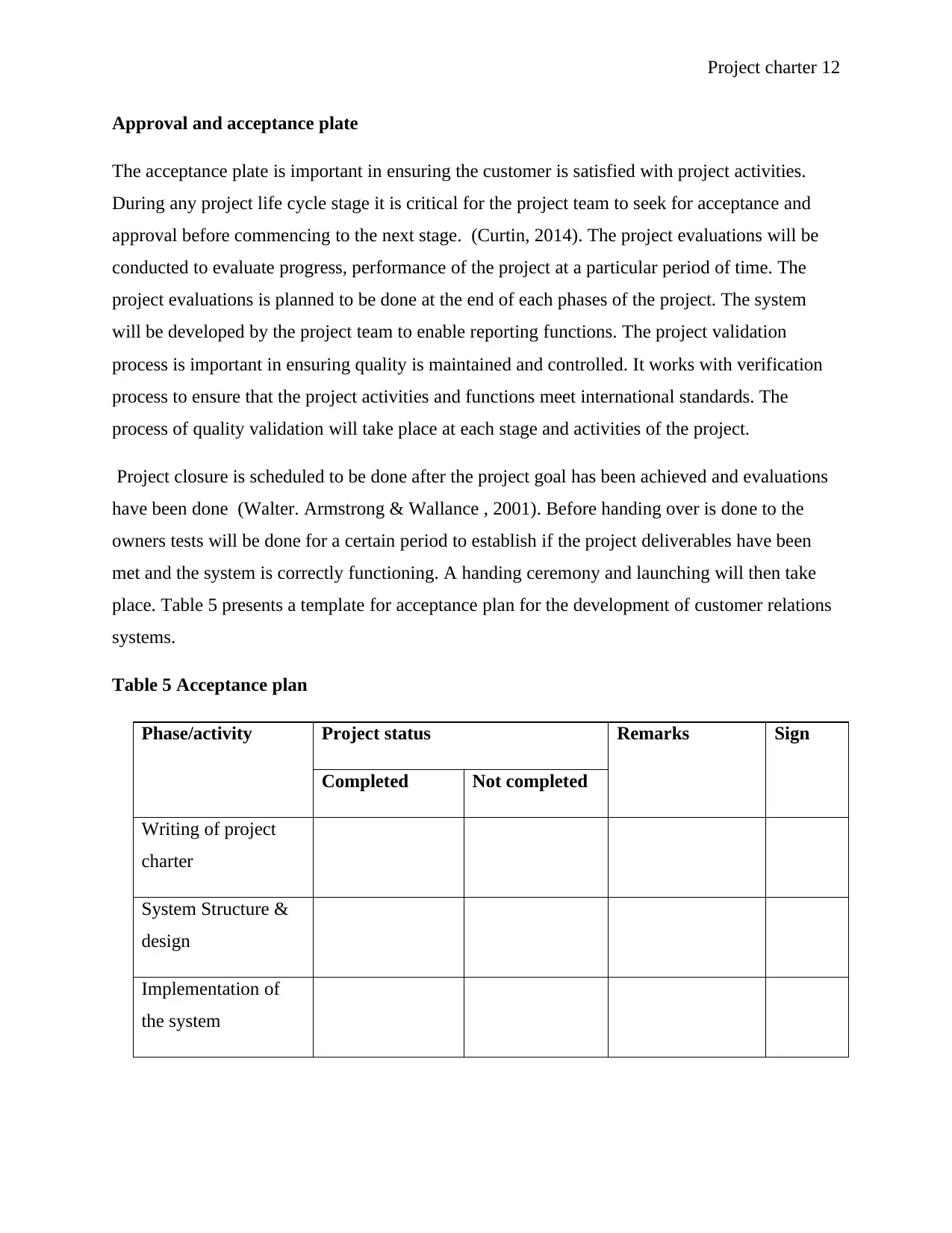
Project charter 12
Approval and acceptance plate
The acceptance plate is important in ensuring the customer is satisfied with project activities.
During any project life cycle stage it is critical for the project team to seek for acceptance and
approval before commencing to the next stage. (Curtin, 2014). The project evaluations will be
conducted to evaluate progress, performance of the project at a particular period of time. The
project evaluations is planned to be done at the end of each phases of the project. The system
will be developed by the project team to enable reporting functions. The project validation
process is important in ensuring quality is maintained and controlled. It works with verification
process to ensure that the project activities and functions meet international standards. The
process of quality validation will take place at each stage and activities of the project.
Project closure is scheduled to be done after the project goal has been achieved and evaluations
have been done (Walter. Armstrong & Wallance , 2001). Before handing over is done to the
owners tests will be done for a certain period to establish if the project deliverables have been
met and the system is correctly functioning. A handing ceremony and launching will then take
place. Table 5 presents a template for acceptance plan for the development of customer relations
systems.
Table 5 Acceptance plan
Phase/activity Project status Remarks Sign
Completed Not completed
Writing of project
charter
System Structure &
design
Implementation of
the system
Approval and acceptance plate
The acceptance plate is important in ensuring the customer is satisfied with project activities.
During any project life cycle stage it is critical for the project team to seek for acceptance and
approval before commencing to the next stage. (Curtin, 2014). The project evaluations will be
conducted to evaluate progress, performance of the project at a particular period of time. The
project evaluations is planned to be done at the end of each phases of the project. The system
will be developed by the project team to enable reporting functions. The project validation
process is important in ensuring quality is maintained and controlled. It works with verification
process to ensure that the project activities and functions meet international standards. The
process of quality validation will take place at each stage and activities of the project.
Project closure is scheduled to be done after the project goal has been achieved and evaluations
have been done (Walter. Armstrong & Wallance , 2001). Before handing over is done to the
owners tests will be done for a certain period to establish if the project deliverables have been
met and the system is correctly functioning. A handing ceremony and launching will then take
place. Table 5 presents a template for acceptance plan for the development of customer relations
systems.
Table 5 Acceptance plan
Phase/activity Project status Remarks Sign
Completed Not completed
Writing of project
charter
System Structure &
design
Implementation of
the system
⊘ This is a preview!⊘
Do you want full access?
Subscribe today to unlock all pages.

Trusted by 1+ million students worldwide
1 out of 14
Related Documents
Your All-in-One AI-Powered Toolkit for Academic Success.
+13062052269
info@desklib.com
Available 24*7 on WhatsApp / Email
![[object Object]](/_next/static/media/star-bottom.7253800d.svg)
Unlock your academic potential
Copyright © 2020–2025 A2Z Services. All Rights Reserved. Developed and managed by ZUCOL.





